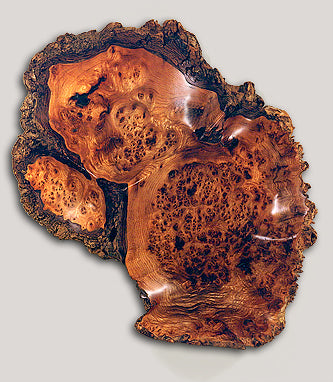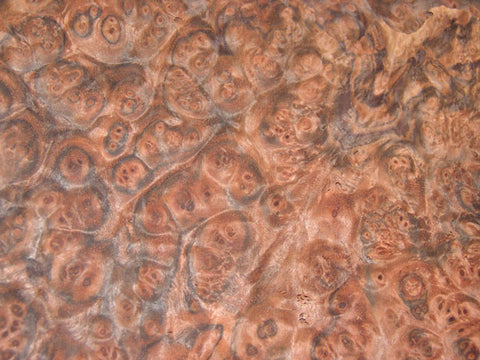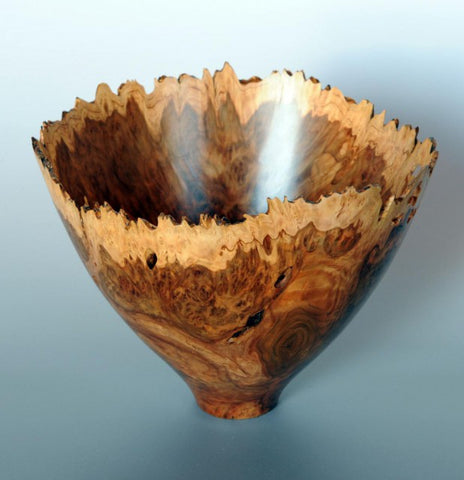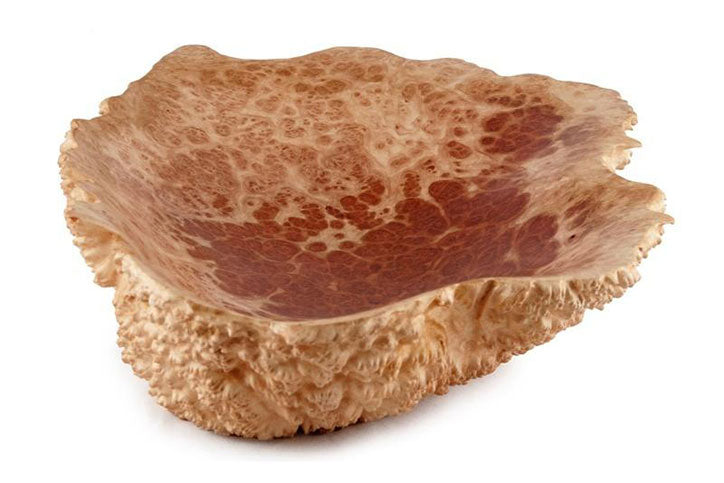Australian Eucalyptus Burls: What exactly is a Burl?
We receive a lot of enquiries about our products that are made from Eucalypt Burls of the type, “What are Burls?” “Why are these products expensive?” “Why can't I order a matching product or bowl?” etc, so in this article, we will attempt to answer those questions.

Burls are also known as 'burrs' in the US and the UK - the dashboards of Jaguars are traditionally made from Burr Walnut with the lovely swirly patterns typical of burls or burrs. Burls form on tree roots, trunks and branches as a result of the abnormal development of bud growth cells. They appear as wartlike lumpy growths, roundish in shape and covered in coarse bark. Burls contain twisted, compact wood that is tougher than the wood from the rest of the tree.

Opinions vary as to the causes of burls but most experts agree on several factors, the first being disease. Although burl formation has not yet been fully analysed it seems able to be attributed to several diseases caused by bacteria, fungi or viruses with mould infestations being held as the most common cause. Infections just below the tree bark seem to trigger these abnormal growths with the tree's cells continuing to grow at the same rate as the rest of the tree but in a drastically changed direction.
Environmental stress and physical trauma also contribute to burl formation. The former can include a response to injuries from fire or flood or irritation from constant wind or water erosion. Physical trauma can include insect damage, wounds from animals or injuries from logging. In many cases, it will be a combination of factors that will cause burl growth and anything that can injure a tree has the potential to cause it.

There are some trees, however, with Eucalypts being one of them, that are genetically predisposed to form burls. These burls are more like big clumps of unformed bud clusters which could resprout into a branch or even a whole tree if the primary stem were injured. These burls display wild grain patterns that are prized by woodworkers and furniture makers who use them for decorative accents. Burls, deviating from the close straight grain of the trunks, display grain that is typically wavy, curly, swirled or bird's eye and for this reason, is much prized by woodworkers.

The flip side of a burl's beautiful grain is that it is extremely difficult to work with because of the structural weakness that the abnormal growth generates. As mentioned previously, burls contain twisted compact wood whose cells do not grow in the nice straight lines of the wood in the main part of the trunk so when a burl is put on a lathe to be turned into a bowl and a large amount of mass is removed from its centre it can behave in very unpredictable ways.
All the competing stresses and tensions in its dense twisted grain are suddenly released with the result that it will skew off-centre, warp and twist into a very un-bowl-like shape. The turner then has to rest the burl/bowl for some time to let it settle and then do another turning to reshape the bowl and make it round again.
This process may have to be repeated several times over many months to achieve a bowl or vase that is stable and sound and will not warp or twist out of shape. So a burl has to be harvested, dried, turned and rested several times, sanded and finally polished - a process that can take a year from start to finish. Woodworkers have lots of burls in different stages on the go at any one time but it is still a time-consuming process.
The final point to make about woodworkers and burls is that they are hard to come by. They cannot be ordered from your local timber supplier and only a few very specialised providers deal in them, so most woodworkers go out bush bashing and do their harvesting which again takes time and means weeks per year away from the workshop.
And lastly, no two burls are similar to each other. They may be from the same type of Eucalypt such as Redgum or Red Mallee and will perhaps, but not always, display some likeness of colour, but trying to match up products in burl timber is extremely difficult. We recommend that the unique quality of each burl be treasured for its particular pattern and colour. Timber does not need to be matchy-matchy, its different hues and grains complement each other rather like flowers in a flower garden.


















































































































We have just had a large bloodwood burl cut of our tree and want to know how to sell it and what it might be worth. We live in Coffs Harbour.
Hi, I have a selection of whole jarrah burls, burl blanks and cut burl slabs. Could u possibly assists in finding buyers? Any help would be appreciated.
I’ve got a Lachlan River redgum burl – known for impressive fiddleback. 1150mm wide x 600mm high (when lying flat) what would it be worth and where best to advertise it?
Hi how r u just wanted to no if u could help me I have around 20+ Burl’s ranging from small to massive but I need some advice on where to sell them please thank you
Fantastic I have a Burl in the rough and would love to have the skills to turn it into something really good.